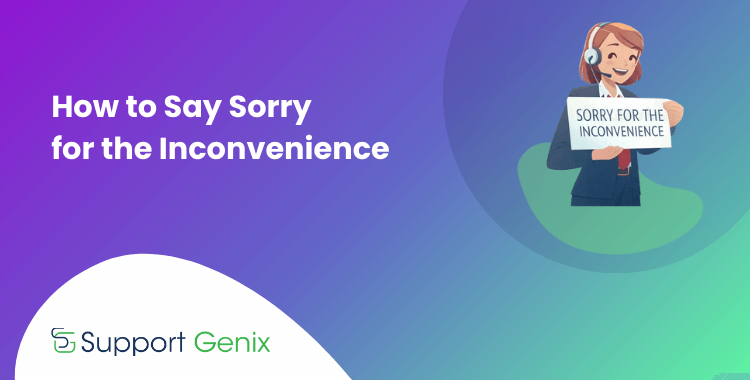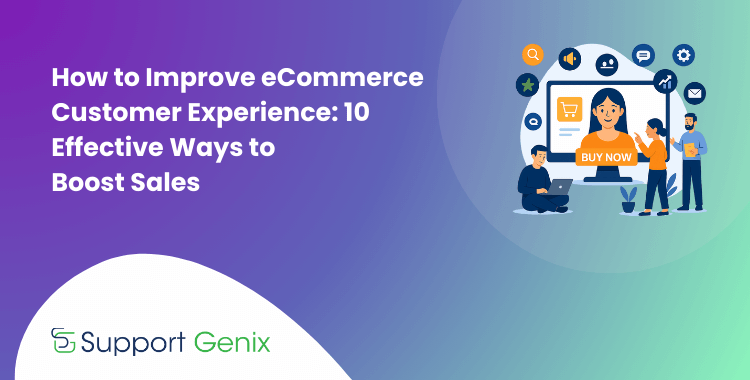How to Improve Customer Engagement: 7 Crucial Strategies
Ever wonder why some businesses have customers who can’t stop talking about them, while others struggle to get a single review? The secret lies in customer engagement.
Here’s a shocking stat: Companies with engaged customers see 23% higher profits, 18% higher revenue growth, and 12% better customer retention. Yet 70% of businesses still treat engagement like an afterthought.
The problem? Most companies focus on getting new customers instead of engaging the ones they already have. Big mistake.
This guide shows you exactly how to fix that. You’ll discover 7 proven customer engagement strategies that turn casual buyers into raving fans. No fluff, just actionable tactics you can implement today.
Ready to transform your customer relationships? Let’s dive in.
Support Genix
WordPress Support Ticket Plugin
Take Your Customer Support to The Next Level and Boost Customer Satisfaction Rates
How to Improve Customer Engagement: Start Here
Before jumping into strategies, let’s get clear on what customer engagement actually means.
It’s NOT just:
- Sending weekly newsletters
- Posting on social media
- Having a contact form
Real engagement is about creating meaningful connections that make customers want to interact with your brand repeatedly. Think of it as building friendships, not just transactions.
The engagement formula: Value + Consistency + Personalization = Engaged Customers
When done right, engaged customers become your biggest advocates, spending more and referring others without being asked.
Strategy 1: Make Every Interaction Personal
Personalization transforms generic communication into meaningful connections that customers actually care about. By using customer data like names, purchase history, and preferences, you create tailored experiences that feel relevant. This approach increases email open rates, improves customer satisfaction, and builds stronger emotional bonds with your brand.
Generic messages = instant delete. Personal messages = actual engagement.
Quick wins:
- Use customer names in emails (increases open rates by 26%)
- Segment your audience by interests, not just demographics
- Show relevant products based on browsing history
- Send birthday discounts or anniversary messages
Digital customer engagement thrives on personalization. Netflix doesn’t show everyone the same homepage – they customize it based on viewing habits. You should do the same.
Customer engagement examples that work:
- “Hey Sarah, noticed you loved our marketing course. Here’s an advanced strategy just for you…”
- Product recommendations: “Since you bought X, you might love Y”
- Location-based offers: “Special deal for Chicago customers”
Pro tip: Start small. Even adding someone’s name to your subject line beats sending “Dear Valued Customer” emails.
Strategy 2: Use the Right Customer Engagement Tools
The right technology stack automates engagement processes and helps you manage customer relationships at scale. Modern tools like CRM systems, email platforms, and support solutions work together to create seamless customer experiences. Without proper tools, even the best engagement strategies fail due to manual overwhelm and inconsistent execution.
You can’t manage engagement manually. You need systems that work 24/7.
Essential customer engagement tools:
- CRM system: Track every customer interaction.
- Email marketing platform: Automated, personalized campaigns.
- Live chat software: Instant customer support.
- Social media scheduler: Consistent posting.
- Analytics tools: Measure what’s working.
For WordPress users, customer engagement solutions like Support Genix can transform your support system into an engagement engine. Instead of just solving problems, you’re building relationships through every ticket.
The tool stack hierarchy:
- CRM (foundation)
- Email marketing (nurturing)
- Support system (problem-solving)
- Analytics (optimization)
Don’t try to implement everything at once. Pick one tool, master it, then add more.
Strategy 3: Build Your Customer Engagement Plan
A strategic engagement plan provides the roadmap for all customer interactions, ensuring every touchpoint serves a specific purpose. Without clear goals, customer journey mapping, and success metrics, engagement efforts become scattered and ineffective. Strategic planning helps you prioritize resources and measure what actually drives business results.
Flying blind leads to frustrated customers and wasted money. You need a clear customer engagement plan.
Your 4-step planning process:
Step 1: Define Goals
- Increase retention by 15%?
- Boost repeat purchases by 25%?
- Improve customer satisfaction scores?
Step 2: Map Customer Journey
- How do customers discover you?
- What’s their buying process?
- When do they typically need support?
Step 3: Choose Touchpoints
- Welcome sequences for new customers
- Educational content for prospects
- Win-back campaigns for inactive users
Step 4: Set Success Metrics
- Email open rates
- Support ticket resolution times
- Customer lifetime value
Your customer engagement model should be simple to start. Complexity kills execution.
Strategy 4: Master Multi-Channel Communication
Modern customers interact with brands across multiple platforms and expect consistent experiences everywhere. Multi-channel engagement ensures you meet customers where they are, whether that’s email, social media, or your website. Consistency across all channels builds trust and reinforces your brand identity in customers’ minds.
Customers are everywhere: email, social media, your website, phone. You need to be everywhere too, with consistent messaging.
How to increase customer engagement across channels:
- Email: Educational newsletters, product updates, exclusive offers
- Social Media: Behind-the-scenes content, customer features, quick tips
- Website: Live chat, helpful resources, easy contact options
- Phone/Support: Quick responses, helpful solutions, follow-up
- The golden rule: Same brand voice, adapted to each platform.
Your Facebook posts can be casual and fun. Your support emails should be professional and helpful. But both should sound like they’re from the same company.
Quick channel optimization:
- Email: Personalized subject lines
- Social: Ask questions, start conversations
- Website: Add live chat during business hours
- Support: Follow up after resolving issues
Strategy 5: Create Feedback Loops That Actually Work
Systematic feedback collection and action create a cycle of continuous improvement that customers notice and appreciate. When customers see you implement their suggestions, they become more invested in your success and engage more actively. The key is not just collecting feedback, but closing the loop by making visible improvements and communicating changes back to customers.
Most businesses ask for feedback but do nothing with it. That’s worse than not asking at all.
Smart feedback collection:
- Post-purchase surveys – “How was your experience?” (2-3 questions max)
- Support follow-ups – “Did we solve your problem?”
- Social listening – Monitor mentions and hashtags
- Review requests – Ask happy customers to share their experience
Customer engagement ideas and strategies for feedback:
- Send a quick 1-question survey after support interactions
- Create a customer advisory board for your best clients
- Use polls on social media to involve customers in decisions
- Implement suggestion boxes on your website
The feedback action loop:
- Collect feedback
- Analyze patterns
- Make improvements
- Tell customers what you changed
- Repeat
When customers see you actually use their input, they engage more.
Strategy 6: Let Data Drive Your Decisions
Analytics provide the insights needed to optimize engagement strategies and allocate resources effectively. Data reveals which tactics actually work, where customers drop off, and what drives the highest lifetime value. Making decisions based on metrics rather than assumptions leads to better engagement outcomes and improved ROI.
Gut feelings are nice. Data is better.
Key customer engagement analytics to track:
- Email metrics: Open rates, click rates, unsubscribe rates
- Website engagement: Time on site, pages per visit, bounce rate
- Support metrics: Response time, resolution rate, satisfaction scores
- Social engagement: Likes, comments, shares, mentions
- Revenue metrics: Customer lifetime value, repeat purchase rate
Customer strategy based on data beats guesswork every time.
Simple analytics setup:
- Google Analytics for website behavior
- Email platform analytics for campaign performance
- Social media insights for engagement rates
- CRM reports for customer lifetime value
Weekly data review questions:
- Which content gets the most engagement?
- What support issues come up repeatedly?
- Which customers are most valuable?
- Where are we losing people in the funnel?
Recommended Blog for You:
👉 What is Customer Engagement? A Complete Guide for Support Teams
👉 Customer Intent: How Support Teams Can Decode It
👉 How to Improve eCommerce Customer Experience
👉 Top 10 Customer Experience Experts You Should Be Following
👉 5 Tips to Improve Your SaaS Customer Support Strategy
Strategy 7: Focus on Long-Term Value, Not Quick Wins
Sustainable engagement comes from consistently providing value rather than constantly pushing for sales. When businesses prioritize customer success and education over transactions, they build stronger emotional connections that last. This value-first approach transforms customers into loyal advocates who naturally engage more and refer others.
The best customer engagement strategies play the long game.
Instead of constantly pushing sales, focus on becoming genuinely helpful.
Value-first engagement tactics:
- Educational content: How-to guides, industry insights, best practices
- Community building: Facebook groups, forums, user meetups
- Customer success: Check-ins, optimization tips, growth advice
- Recognition: Feature customers, celebrate their wins, share their stories
How to improve customer engagement for the long haul:
- Share valuable content weekly (not always promotional)
- Create spaces for customers to connect with each other
- Celebrate customer achievements publicly
- Provide ongoing education about your industry
When you focus on customer success instead of just sales, engagement naturally increases.

Frequently Asked Questions
What customer engagement tools work best for small businesses?
Start with email marketing (Mailchimp), a simple CRM (HubSpot free), and basic social scheduling (Buffer). For WordPress sites, Support Genix handles customer support efficiently. Add tools gradually as you grow.
How often should I contact customers?
Quality over quantity. Weekly newsletters work for most businesses. Social media can be daily if you have valuable content. The rule is that every message should provide value, not just ask for something.
Which engagement metrics actually matter?
Focus on business impact: customer lifetime value, retention rate, and Net Promoter Score. Vanity metrics like follower count don’t pay the bills. Track metrics that directly connect to revenue.
How can I personalize without coming across as creepy?
Use data customers willingly share: purchase history, website behavior, stated preferences. Avoid personal details they haven’t given you. Good personalization helps customers; it doesn’t make them uncomfortable.
What’s the difference between engagement and satisfaction?
Satisfaction means customers aren’t complaining. Engagement means they’re actively participating – sharing content, referring friends, providing feedback, staying loyal. Engagement is satisfaction plus emotional connection.
How do I re-engage inactive customers?
Send a “we miss you” email with genuine value – exclusive content, special discount, or helpful resource. Ask what went wrong. If they don’t respond after 2-3 attempts, let them go to protect your sender’s reputation.
Conclusion
Customer engagement isn’t rocket science, but it does require consistency and genuine care for your customers.
Start with one strategy that resonates most with your situation. Master it, measure results, then add another. Don’t try to implement everything at once – that’s a recipe for failure.
The businesses winning today aren’t necessarily the ones with the best products. They’re the ones building the strongest relationships with their customers.
To improve customer engagement effectively, remember this: treat customers like people, not numbers. Provide genuine value. Be consistent. Measure what matters.
Your customers will notice the difference. And they’ll reward you with their loyalty, referrals, and repeat business.
Ready to get started? Pick one strategy from this list and implement it this week. Your future self (and your customers) will thank you.


